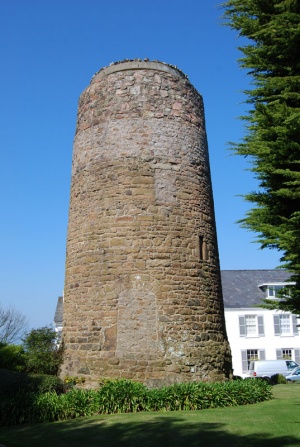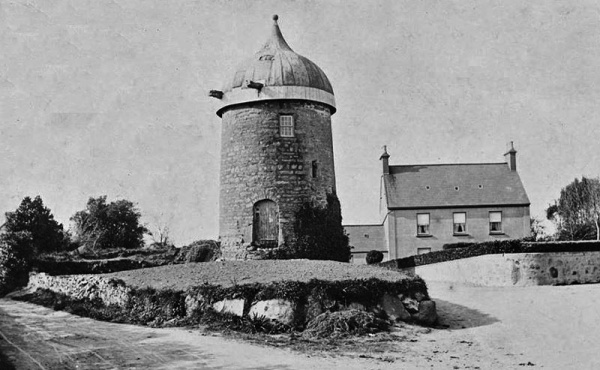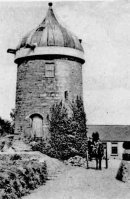Historic Jersey buildings
If you own this property, have ancestors who lived here, or can provide any further information and photographs, please contact us through editorial@jerripedia.org |
Property name
Moulin de Rozel [1]
Other names
- Rozel Mill
- St Martin's Mill
Location
Rue du Moulin, St Martin [2]
Type of property
Windmill, no longer functioning
Valuations
No recent transactions
Families associated with the property
Historic Environment Record entry
Listed building
Windmill tower of medieval origin (perhaps as early as the 14th century), used as navigation mark from 1919 and then converted to German coastal artillery observation post M6 in 1940s.
The later history of Rozel windmill can be traced through the Public Registry where it is recorded with the Manor and Fief from 1626 (RP7/375) until it was sold away from the Fief by Philippe Raoul Lemprière (Seigneur de Rozel) to David Anley in 1833 (RP 156/141), when there was also a horse mill at the site, together with an adjacent house.
Anley sold in 1862 to Edouard Philippe Noel, who sold the mill on two months later. The cap is believed to have been removed in 1909.
The States of Jersey acquired the windmill (which was then described as ruinous) from Philip Vardon for the sum of £120 on 7 June 1919. It was purchased for use as a navigation mark, particularly for fishermen returning from Les Ecréhous.
Shown on the Richmond Map of 1795.
The exact date of the original structure has not yet been ascertained but an examination of the extant fabric; together with documentary and cartographic evidence, show it to be of significantly early construction for a stone mill. The Assize Roll of 1309 refers to a mill on the fief of Rozel as having being burnt during time of war; whether this was an early watermill or a windmill is not apparent.
It is not known if this original mill was a stone tower or a wooden post-mill. The depiction of the mill on Popinjay's map of 1563 shows a stone tower mill whereas the Speed map of 1610 shows a post-mill - although it seems unlikely that a tower mill would have been replaced by a post-mill at that time. [3]
In the partage (1382) between Drouet Lemprière and Guillaume Payn, of the fiefs they had jointly acquired form Philippe de Barentin (the last of the de Barentins), Lemprière took Rozel with the undefined 'moulins' (in the plural).
Rozel Mill has a cylindrical tower which indicates it may be of very early date.
Rozel Mill may be of international importance. The main body of the structure appears to date to the 14th-16th century. There are two bands of later construction above - one relating to the early 20th century adaptation to a navigation mark, and the upper level dating to the conversion to a German coastal artillery observation post in the 1940s.
There are two entrance doors - one (blocked) approximately due south and the other approximately due north (with German steel blast door in situ). Both have irregular quoins and a double row of voussoirs over the doorway. This is indicative of an early construction date and is not a typical feature of later 18th/19th century Jersey mills, such as St Ouen's Windmill and St Peter's Windmill - built in the 1830s - both of which have a flat stone lintel over the doorway.
It is also notable that St Peter's Windmill and St Ouen's Windmill are conical in shape, whereas the walls of Rozel Windmill are nearer to the vertical. Rising in a spiral from the right of each door are two small blocked loophole openings - suggestive of an internal spiral stair against the outer wall.
The tower has been raised on two occasions. The first, by deduction, between the sale of the ruin in 1919 and the German Occupation. The second raising was by the Germans during the Occupation. The Germans lined the interior of the tower with a concrete sleeve poured between the tower wall and timber shuttering. All earlier openings except the north door are masked by the sleeve and the original interior floor levels are not clear. The Germans inserted four floors supported on steel girders with metal shuttering.
To the north is an extensive mid-19th century property retaining its proportions and external historic character, with many features.
Old Jersey Houses
There is no specific profile of the mill, but it is mentioned in the pages covering the history of windmills and water mills in the island. The author believed the original mill to have been built by de Barentin, Seigneur de Rozel, before 1329.
Notes and references
- ↑ The mill is described in French by HER but is universally known, and has been for a long time, as Rozel Mill or St Martin's Mill
- ↑ St Martin has two Rues du Moulin. This one is above Rozel, the other is near St Catherine, where Moulin de La Perrelle, the parish water mill, is situated
- ↑ Map makers in the 16-17th centuries tended to use generic symbols of their choice to illustrate mills and other important structures, rather than making any attempt to illustrate the actual mills - Ed









